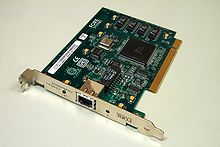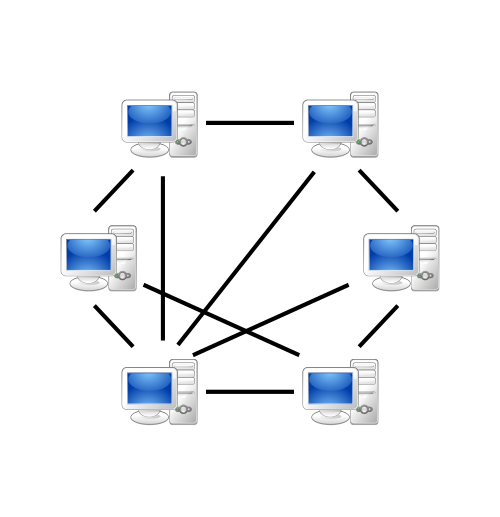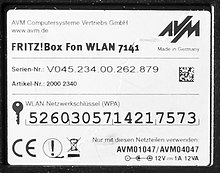Communication
Specification
[edit | edit source]|
Specification coverage
|
Introduction
[edit | edit source]One of the key aspects of computing is communication. For example, input and output devices need to communicate with the processor, the hard disk needs to communicate with memory and so on.
Communication in this sense takes place through the transmission of data and instructions. We have already looked at many examples of data transmission inside the computer. In this section, we are more concerned with communication between computers and peripheral devices and also between one computer and another across local and global networks. This section will also include a detailed record of the infrastructure that makes up the Internet.
Network basics
[edit | edit source]| In general, the level of detail required in definitions of thinks like networks will be higher in A-level exams than in AS exams. |
A network is any number of computers connected together for communication, sharing processing power, storage capacity and other resources. In order to connect to a network, a computer must have a network adapter, more commonly know as a Network Interface Card (NIC).

The NIC is a printed circuit board which is contained inside the computer like any other card (graphics and sound cards, for example). The NIC will be specifically designed to allow the computer to connect either via cable or wirelessly to the particular network topology being used. The type of card also dictates the speed of data transmission that will be available between devices and the network. These are typically already integrated into modern motherboards.
Networks are usually described in terms of geographical area that they cover and the way in which the connections are configured, known as network topology.
A Local Area Network (LAN) is a number of computer and peripherals connected over a small geographical distance, covering one building or site. Most LANs are made up of one or more servers and clients. A server is a high specification computer with sufficient processing power and storage capacity to service a number of users. A client is any computer attached to the network.
A Wide Area Network (WAN) is a number of computers and peripherals connected together over a large geographical distance. This could mean any network that extends beyond a single site right up to global networks such as the Internet. WANs make use of a wider variety of communication media including telephone wires, microwaveable links, satellite connections and fibre optic cables.
| LANs are normally owned and operated by a single organisation. WANs may be owned/operated by multiple organisations and will commonly use third-party communication technology. |
In addition to the server and client the other critical device within a network is a router. Modern routers are actually a number of devices merged together into a single device. The typical router for a home network:
- receives every packet of data being transmitted, reads the header of the packet and then forwards it to its destination
- acts as a firewall, preventing certain packets from being forwarded
- acts as a switch, creating a connection between two devices on a network
- provides a wireless access point transmitting a WiFi signal
- acts as a modern to convert digital signals to analogue so that they can be transmitted down standard telephone cables.
Star topology
[edit | edit source]
A star topology takes its name from the simplified way in which it can be represented on paper as shown in image below. This shows the devices are conceptually connected together.

The image above shows each client connected to a central server via individual connection. The main feature is the dedicated connection between server and client. In reality it will be a switch in the centre with server attached to one of the ports. The server will be high specification machine with a large amount of processing power and storage capacity. The clients have access to the server through the cabling.
Advantages and disadvantages
[edit | edit source]| Advantages | Disadvantages |
|---|---|
| Fast connection speed as each client has a dedicated cable | Expensive to set up due to increased cabling costs |
| Will not slow down as much as other network topologies when many users are online | If the cable fails then that client may not be able to receive data |
| Fault-finding is simpler as individual faults are easier to trace | Difficult to install as multiple cables are needed. The problem is exaggerated where the LAN s split across a number of buildings |
| Relativity secure as the connection from client to server is unique | The server can get congested as all communications must pass through it |
| New clients can be added without affecting the other clients | |
| If one cable or client fails, then only that client is affected |
Bus topology
[edit | edit source]
The other main network topology is the bus topology, where all of the nodes within the network are connected via one main cable. If there is a main server, all of the clients connect to it down this main cable. This cable carries data between the server and the clients with each client branching off the main bus cable.

The main cable or backbone must allow high-speed data transmission as all data must pass down this one channel. A common implementation of the bus system is an Ethernet network system.
Advantages and disadvantages
[edit | edit source]| Advantages | Disadvantages |
|---|---|
| Cheaper to install than a star topology as only one main cable is required | Less secure than a star network as all data are transmitted down one main cable |
| Easier to install than a star topology | Transmission times get slower when more users are on the network |
| Easy to add new clients by branching them off the main cable | If the main cable fails, then all clients are affected |
| Less reliable than a star network due to reliance on the main cable | |
| More difficult to find faults |
Physical and logical topologies
[edit | edit source]
There is a distinction to be made between the physical topology and logical topology of a network. Physical topology refers to actual connection of cables. However, it is possible for networks that are connected in a particular physical topology to act in a different way with the addition of more hardware and software. For example, some Ethernet networks were physically laid out as a star, but used hubs to repeat signals, which effectively creating a bus networks.
Client-server networks
[edit | edit source]| Don't fall into the trap of thinking that client-server and peer-to-peer networks are restricted to certain topologies. |
In the star and bus topologies, the diagram shows a main server. Although the clients have local resources in terms of processing power and storage capacity, they are dependent upon the server. This is the most common way of constructing a LAN with a large number of users. The server will be a high-end computer with a large amount of processing power and storage capacity. It needs to be big enough and fast enough to cope with the demands placed upon the clients.

Peer-to-peer networks
[edit | edit source]
In a peer-to-peer network, no one computer is in overall control of the network. Instead the resources of each computer or workstation are available to all the computers in the network. Each workstation therefore can act either as a client or a server, depending on the current task. This more common among smaller networks on for certain applications such as file sharing.

| Peer-to-peer networks are often used at home where every computer and device has equal rights. |
Recap: Peer-to-peer and client server networks compared
[edit | edit source]| Characteristic | Peer-to-peer | Client-Server |
|---|---|---|
| Who's in charge? Where is the control? | No one / Everyone | Server |
| How are resources shared | On a individual basis | Centrally by the server to users/groups |
| Does it need a special OS? | No | Yes |
| Simple/hard to setup | Simple | Needs system admin |
| Cost | Low | High(er) (server can be expensive as can sys admin software) |
| Secure? | Lower | Higher (but needs expertise) |
Wireless networks
[edit | edit source]
A wireless network varies from a wired network in that it does not use cables to make the physical connections between devices. Instead the data is sent using radio waves. Wireless networks can be implemented over small or large geographical distances so it is possible to have a wireless LANs (WLAN) and wireless WANs (WWAN). Many business and home networks are set up wirelessly, doing away with the need for costly cabling and enabling easy access to the network from any device with a wireless network adapter (NIC).
All devices on a network have a Media Access Control (MAC) address. This is a unique identifier encoded into the network interface card (NIC) in the format of six groups of two hex digits separated by colons, e.g. 02:32:45:77:89:ab. Any device that connects to a network using WiFi will connect through a wireless access point and must have its own unique MAC address. Every NIC ever manufactured has a unique address meaning that they can be used to identify every device uniquely. The first half of the MAC address is the manufactured code and the second half is the unique device code allocated network adapter (NIC).
WiFi is the generic term for a Wireless Local Area Network (WLAN) where devices can connect wirelessly to each other and where a connection can be made to the Internet providing one of the devices in the network is online. WiFi operates to a generic standard called IEEE 802.11, ensuring that all devices are compliant and can connect and transmit data around the network.
Advantages and Disadvantages of Wireless Networks
[edit | edit source]| Advantages | disadvantages |
|---|---|
| low set-up costs | interference can occur and is slower than wired networks |
| not tied down to a specific location | the connection is not as stable as wired networks and can 'drop off' |
| can connect multiple devices without the need for extra hardware | more open to hacking |
| less disruption to the building due to no wires being installed | it will lose quality through walls or obstructions |
The purpose of Service Set Identifier (SSID)
[edit | edit source]SSID is simply the technical term for a network name.
When you set up a wireless home network, you give it a name to distinguish it from other networks in your neighbourhood.
You'll see this name when you connect your computer to your wireless network.
An SSID is the primary name associated with a 802.11 wireless local area network (WLAN) including home networks and public hotspots.
On home Wi-Fi networks, a broadband router or broadband modem stores the SSID and allows administrators to change it.

Routers can broadcast this name to help wireless clients find the network
How wireless networks are secured
[edit | edit source]Strong encryption of transmitted data can be done using WPA /WPA2, SSID (Service Set Identifier) broadcast disabled, MAC (Media Access Control) address white list:
- WPA - wireless protected access
Wi-Fi Protected Access (WPA) is a security standard for users of computers equipped with a wireless connection. It is an improvement on and is expected to replace the original Wi-Fi security standard, Wired Equivalent Privacy (WEP). WPA provides more sophisticated data encryption than WEP and also provides user authentication. WEP is still considered useful for the home user, but insufficient for the corporate environment where the large flow of messages can enable hackers to discover encryption keys more quickly.

- WPA2
Stands for Wi-Fi Protected Access 2, the follow-on security method to WPA for wireless networks that provides stronger data protection and network access control. It provides enterprise and consumer Wi-Fi users with a high level of assurance that only authorised users can access their wireless networks. Based on the IEEE 802.11i standard, WPA2 provides government grade security
- SSID Broadcast disabled
Most routers and other wireless access points automatically transmit their network name (SSID) at regular intervals (every few seconds). This SSID broadcasting feature of Wi-Fi network protocols is intended to allow clients to dynamically discover and roam among wireless networks (WLANs). For security, this feature can be disabled. The tradeoff is between security and the convenience of setting up new networking clients.
- MAC Address white list
A media access control address (MAC address), also called physical address, is a unique identifier assigned to network interfaces cards (NICs) for communications on the physical network. Many network admins set up MAC address whitelists, or a MAC address filter, to control who is allowed on their networks. This is used when encryption is not a practical solution or in tandem with encryption.

The wireless protocol: Carrier Sense Multiple Access with Collision Avoidance (CSMA/ CA) without Request to Send/Clear to Send (RTS/CTS)
[edit | edit source]As in wired networks, a protocol describes the rules of data communication that the sender and receiver follow. CSMA/CA acts to prevent collisions before they happen.
- As soon as a node receives a packet that is to be sent, it checks (CARRIER SENSE) to be sure the channel is clear (no other node is transmitting at the time)
- If the channel is clear, then the packet is sent successfully - an acknowledgment is received
- If the channel is not clear, the node waits for a randomly chosen period of time, and then checks again to see if the channel is clear. This period of time is called the backoff factor, and is counted down by a backoff counter. If the channel is clear when the backoff counter reaches zero, the node transmits the packet. If the channel is not clear when the backoff counter reaches zero, the backoff factor is set again, and the process is repeated.

The wireless protocol: Carrier Sense Multiple Access with Collision Avoidance (CSMA/ CA) with Request to Send/Clear to Send (RTS/CTS)
[edit | edit source]Carrier Sense: prior to transmitting, a node first listens to the shared medium (such as listening for wireless signals in a wireless network) to determine whether another node is transmitting or not.
Collision Avoidance: if another node was heard, the transmitter waits for a random period of time for the node to stop transmitting before listening again for a free communications channel.
Request to Send/Clear to Send (RTS/CTS) is used at this point to mediate access to the shared medium. In a wireless network, the Access Point only issues a Clear to Send to one node at a time.
Think of Request to Send/Clear to Send (RTS/CTS) like a "talking stick" - only the node with the "talking stick" can "talk" (transmit)
Transmission: if the medium was identified as being clear or the node received a CTS to explicitly indicate it can send, it sends the frame in its entirety.
The node awaits receipt of an acknowledgement packet from the Access Point to indicate the packet was received and checksummed correctly.
If such acknowledgement does not arrive in a timely manner, it assumes the packet collided with some other transmission, causing the node to enter a period of backoff prior to attempting to re-transmit.

Disadvantage: the overhead of RTS, CTS and transmission is great for small data transfers.
Handshake protocol
[edit | edit source]Handshaking is an automated process of negotiation that dynamically sets parameters of a communications channel established between two entities before normal communication over the channel begins
RTS / CTS is an example of a handshake protocol
Networking Exercise
[edit | edit source]|
Exercise: Networking
CSMA/CD with RTS/CTS is an example of a handshaking protocol. Explain one purpose of a handshaking protocol.
Answer: To ensure that only once transmitting device transmits at one time and so prevents collisions on the communication medium.
State two advantages of the star topology over the bus topology, and explain how this is achieved.
Answer:
Question Here
Answer:
Answer Here
Question Here
Answer:
Answer Here
Question Here
Answer:
Answer Here
|
